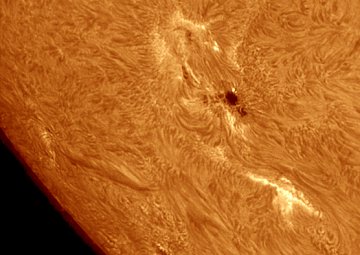 Roses. Candy. Spatulas? Make that the stars: Spaceweather
PHONE for Mother's Day.
Roses. Candy. Spatulas? Make that the stars: Spaceweather
PHONE for Mother's Day.
COMMENTS,
PLEASE: NASA's ACE
spacecraft is almost four years past its intended lifetime.
Although ACE measurements of the solar wind flowing past Earth
are crucial to space weather forecasts, there is no plan to replace
ACE when the craft ceases to function. NOAA is seeking public
comment on this state of affairs. If you enjoy auroras, please
let them
know that ACE needs a successor.
COMET NEWS: Only a few days
ago, fragment B of dying comet 73P/Schwassmann Wachmann 3
split in two. One of those two pieces is now "in outburst,"
almost doubling in brightness since April 23rd. These
false-color images from Rolando Ligustri of
Talmassons, Italy, show the pair yesterday:

The outburst could signal a new breakup of fragment B,
which brightens as fresh veins of ice and dust are exposed to
sunlight. If so, the pair may soon be a triple--or more.
Fragment B is shining like a 9th magnitude star, which
makes it an easy target for backyard
telescopes. Look for it in the constellation Corona
Borealis an hour or so after sunset. The view will only
improve in the weeks ahead as 73P approaches Earth for a close
encounter in mid-May: full
story.
Sky maps: April
26, April
27, April
28, April
29.
BIG SUNSPOT: Sunspot 875 has a
twisted, complex magnetic field that harbors energy for strong
solar flares. So far the spot has not erupted. If you have a
solar
telescope, keep an eye on this region; things could change
in a hurry.

Above: Sunspot 875 on April 25th.
"This new spot is showing a lot of activity," says
photographer Andreas
Murner of Lake Chiemsee, Bavaria, Germany.
more images: from
Robert Arnold on the Isle of Skye, Scotland; from
Ralf Vandebergh in the Netherlands; from
John C McConnell of Maghaberry, Northern Ireland; from
Tom Masterson of Ferndale, Washington; from
Peter Paice of Belfast, Northern Ireland;